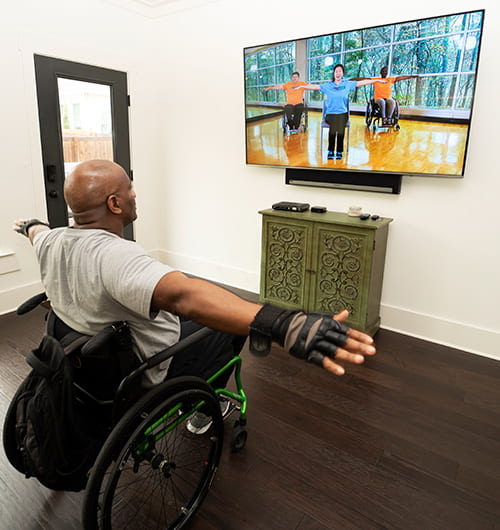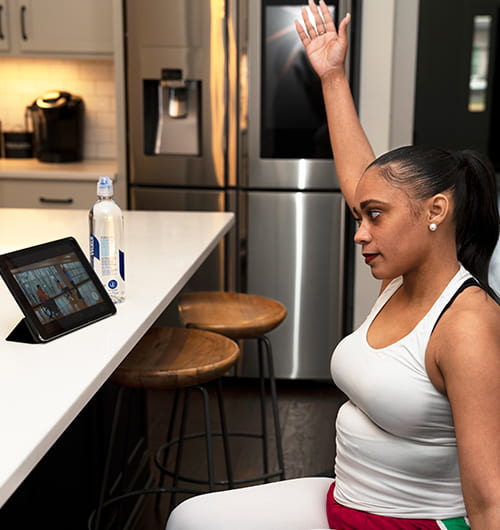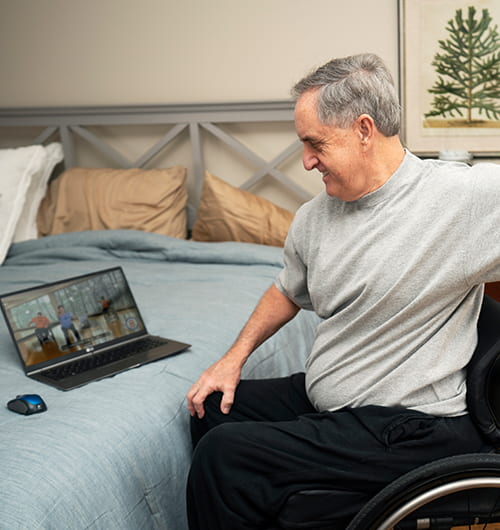Welcome to CHIME
Cardiometabolic Health Intervention using Music and Exercise.
A study seeking convenient and effective exercise doses for a broad spectrum of wheelchair users living with disabilities.
Join the Study
What Will Participating in the Study Look Like?
Participants in the CHIME study will complete choreographed exercise routines designed to be accessible for a broad range of body types and abilities. Participants will also contribute samples of bloodwork as part of their data submission. Our team will offer guidance and support throughout the course of the study, as well as supply all the equipment and $830 in compensation. These exercise doses and resources will ideally act as a foundation for patients to achieve sustainable wellness routines and accomplish their health goals.
CHIME Means Accessible Wellness
We are addressing the high risk of cardiometabolic disease in adults with physical disabilities.
Using choreographed exercise, we aim to provide resources for adults living with certain chronic conditions to achieve improved wellness and reduce their risk of cardiometabolic disease. You can fill out the contact form at the top of this page to request information about joining the study or keep reading to learn more about its purpose and motivation. After you contact us, one of our team members will reach out to you to securely gather your information and evaluate your eligibility to participate in the study.
Exercise While Living with a Disability
Are you seeking a way to improve health and quality of life while living with a disability? The CHIME program is a study designed to explore achievable ways to do just that. Join the study, explore more resources, or keep up to date with our work.
Join the Study
Stay Informed

Frequently Asked Questions
What does CHIME stand for?
CHIME stands for Cardiometabolic Health Intervention using Music and Exercise.
What is the purpose of this study?
The CHIME program is a study designed to test a telehealth protocol aimed at improving cardiometabolic health among wheelchair users (WCU) while removing common barriers to their participation in community/clinical exercise training studies.
There are roughly 5.5 million people in the U.S. alone who could benefit from an accessible exercise program that reduces cardiometabolic risk. However, WCU are gravely underrepresented in studies of such interventions.
We’re focused on presenting participants with desirable and sustainable exercise opportunities and studying the effectiveness of those exercise doses.
Who qualifies as a wheelchair user?
Wheelchair users (WCU) include users of any wheeled devices, such as manual and powered wheelchairs or motorized scooters. This may also include individuals in a variety of disability groups, such as those with spinal cord injuries (SCI), multiple sclerosis (MS), cerebral palsy (CP), spina bifida (SB), or limb loss. These groups combined total roughly 5.5 million people in the U.S. who could all benefit from an accessible exercise program that reduces cardiometabolic risk. Individuals 18 years or older not currently enrolled in an exercise program.
What are cardiometabolic risk factors?
Cardiometabolic risk is a term that refers to risk factors that increase the likelihood of vascular events (i.e. conditions that affect the blood vessels in our body) or developing diabetes.
Some of these risk factors include:
- large waist circumference
- elevated blood pressure, triglycerides, or fasting glucose
- reduced HDL cholesterol
Will I be compensated for my participation?
Yes, the CHIME study offers up to $830 in compensation for your participation. This includes your travel expenses for 6 on-site visits, study equipment (such as tablets and wrist weights), and all exercise content, training, and coaching. There is no cost to you, and you may keep most of the equipment once the study is complete.
We Want You to CHIME In
Join our study to contribute your authentic experience. If you have any questions, don’t hesitate to contact us—we’re happy to help!
Call Us


